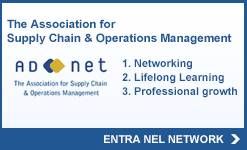Il Master si articola in 3 giornate formative, di seguito i contenuti principali.
Master Certified Professional Forecaster
Testimonianze
Vedi tutti >

DURATA
3 giornate aula / 6 sessioni live webinar in 3/4 mesi

PROSSIMI CORSI
18 Aprile 2026 Milano
11 Aprile 2026 Live Webinar

PREZZO
Corso: Euro 2450 + IVA // Corso + 3 esami IBF: Euro 3860 + IVA
I processi di Demand Planning, Forecasting e S&OP sono fondamentali per impostare un piano di Supply realistico.
IBF, Institute of Business Forecasting & Planning (www.ibf.org), è da decenni l'associazione internazionale di riferimento in questa area e ha creato le certificazione CPF, Certified Professional Forecaster, conosciuta in tutto il mondo.

Advance ha progettato questo Master per trasferire le conoscenze specifiche nell’area Demand Planning, Forecasting e S&OP, basandosi sul BOK di IBF e preparare all'esame per la certificazione internazionale CPF®, Certified Professional Forecaster.
Gli obiettivi del corso sono:
- Validazione delle conoscenze nell’area in base ad un BOK internazionale
- Solida preparazione per affrontare un mercato dinamico
- Ampliamento delle proprie conoscenze
- Padronanza dei processi Demand Planning, Forecasting e SOP
- Maggiore valore sul mercato del lavoro e nella propria azienda
- Presenza nella propria organizzazione di un’alta professionalità nel gestire i processi chiave Demand Planning, Forecasting e SOP: questo risulta in un maggiore valore per l’azienda
- Processi di area implementati in linea con le Best Practice
- Efficacia nel Training, perchè si investe in un programma consolidato e riconosciuto come eccellenza
- Migliori decisioni di Business
- Preparazione alla certificazione CPF®, Certified Professional Forecaster
Il corso viene erogato da docenti certificati con pluriennale esperienza didattica e professionale nell'area Demand Planning & Forecasting.
Su richiesta Advance offre anche programmi di formazione In house.
-
Piano didattico
LEGGI I DETTAGLI ▾
Il Master si articola in 3 giornate nell’arco di 3 mesi, intervallate da un periodo di studio individuale, al termine delle quali si svolge una verifica interna presso la scuola, di sabato. Al superamento dell’esame interno, la scuola rilascia l’attestato CDPF (Certified in Demand Planning & Forecasting) - Advance School.
Le 3 giornate e la verifica interna di Advance coprono completamente il percorso di preparazione alla certificazione CPF.
Al termine del corso, il partecipante avrà maturato la conoscenza per sostenere l’esame CPF® Certified Professional Forecaster di IBF.Per la partecipazione al corso e il superamento dell'esame finale è richiesta una buona conoscenza della lingua inglese.
PROGRAMMA DETTAGLIATO
1. Fundamentals of Demand Planning & Forecasting: People, Processes and Technology:
- Learn how to structure a demand planning process to get the best results for your forecasting &
planning efforts.
- Learn how the forecasting process impacts forecast accuracy and how to gain forecast buy in/acceptance within the organization.
- Learn how forecasts impact management decisions.
- Learn the types of forecasting to be considered in developing a demand planning process.
- Learn approaches to handling products and data patterns, which are easy to forecast, as well as those that are difficult to forecast.
- Learn when to use shipment forecasts, unit forecasts, revenue forecasts as compared to order (demand) forecasts.
- Learn the benefits of consumption based forecasting, also known as POS data forecasting.
2. The Demand Planning & Forecasting Process: Basics of Demand Forecasting and their Drivers for Operations / Supply Chain Planning:
- Learn what the bullwhip effect is, its effect on forecasting & planning, and how to prevent this from happening.
- Learn about the key drivers and the considerations in operations planning/ supply chain management, and the role forecasting plays.
- Learn about the related inventory and customer fulfillment issues that will be of concern to your company operations, and how to manage and hedge against them.
- Learn how to design a demand planning & forecasting process that is goal and decision driven.
- Learn how to establish priorities for forecasting & planning, how much time to spend and where to spend it, as well as how to hedge against the "Un forecastable”.
- Learn how to setup a demand planning consensus meeting and be driven by a single number forecasts.
3. Collaborative Processes: Sales & Operations Planning (S&OP) and Collaborative Planning, Forecasting & Replenishment (CPFR):
- Learn how to design an optimal S&OP process and manage it effectively.
- Learn how to organize and manage S&OP meetings and ensure top management support.
- Learn Demand Sensing & Demand Shaping for balancing supply with demand to achieve company goals.
- Learn the basics of CPFR, success factors, and challenges.
- Learn the nature of POS & Syndicated data, and the valuable market intelligence they provide.
- Learn the sources of syndicated data such as AC Neilson and IRI.
- Learn how to pilot and launch CPFR with key accounts/ customers.
- Learn CPFR process steps and supporting elements, such as the business plan, handling of exceptions, and order policy.
4. Data Management, Planning & Forecasting errors and measurement metrics:
- Learn how to define and locate important data for your forecasting effort.
- Learn how to analyze data to determine patterns that are useful for your planning and forecasting processes.
- Learn how to cleanse data and deal with data outliers, missing data, promotional effects, events, unit of measure mismatches, seasonal and trend effects, and other considerations in ensuring that you have usable and relevant information.
- Learn about different error measurement metrics, and their pros and cons, that can be used to better understand your forecasting and planning performance.
- Learn how to develop Key Performance Indicators (KPI’s) that are most appropriate and applicable to your organization’s needs.
- Learn how to use error as information feedback to improve your future plans and forecasts, as well as a source of business information for your company’s management.
5. Forecasting Models: Time Series Methods and how to select and use:
- Learn how to evaluate and match data patterns with forecast models.
- Learn the fundamental differences between time series forecasting and using cause and effect/regression models.
- Learn how to evaluate accuracy in selecting your model, and how to establish in advance, the expected accuracy and range of forecasts.
- Learn key concepts and terminology of time series forecasting models and methods.
- Learn how to estimate seasonal factors, and improve forecast accuracy.
- Learn how to disaggregate your best category level forecasts into their respective SKU forecasts.
- Learn how to track and prepare forecasts using the sales ratio method.
- Learn how prepare forecasts using several models based on averages, as well as exponential smoothing.
6. Cause & Effect / Regression Models for Forecasting & when they are most appropriate:
- Learn the benefits of cause and effect models as well as when and how to use them.
- Learn how to build a cause and effect model and prepare forecasts that meet your needs.- Learn the necessary data requirements, and transformations that can make your cause and effect models more effective.
- Learn how to validate and gain confidence in your cause and effect forecasts by evaluating and putting the model through diagnostic testing such as ex post forecasting & more.
7. New Product Forecasting & Planning: making decisions when little or no data is available:
- Learn what to expect when developing and forecasting for new products & services.
- Learn what models are available to forecast new products and how to use them in combination, e.g. cause and effect model and diffusion model.
- Learn how to use both quantitative and qualitative methods in combination to get better results in your forecasts.
- Learn how to structure a new product development planning and forecasting process.
- Learn who should be involved and when in the new product forecasting & planning process.
- Learn how to modulate your forecasts and forecast methods as the new products approach their launch time.
- Learn the role of judgment and how collaborative efforts improve new product forecasts & plans.
8. Demand Planning & Forecasting Software Systems: Selection, audits and more:
- Learn why it is important to determine the process first and then decide on the system that aligns with the process.
- Learn who should be involved in identifying the process you need as well as validating the process prior to a software application roll out.
- Learn the pros and cons of using software to automate processes.
- Learn what attributes to look for in a forecasting software/ system that is best for you.
- Learn how to determine the need for a forecasting & demand planning application.
9. Corporate benchmarks, best practices, and gaining buy-in through better communication in Demand Planning & Forecasting:
- Learn about dealing with difficult people, resolving conflict, dealing with a range of people who have different needs and priorities.
- Learn the basics of running an effective review meeting, how to structure an appropriate agenda, and how to prepare the most effective presentation materials.
- Learn how to more effectively communicate with different levels of management and professionals and managers in different functional areas of the company.
- Learn some of the most important characteristics in communicating forecasts based upon the experience of demand planners & forecasters at best in class companies.
- Learn about the best practices of companies in developing models and accurately forecasting with them.
- Learn how best practices/ best in class companies use software to support their forecasting models and data needs, as well as how they track their accuracy over time.
-
A chi si rivolge
Il corso si rivolge alla seguenti figure professionali:
LEGGI I DETTAGLI ▾
- Demand Planning Manager
- Demand Planner
- Supply Chain Manager
- Forecasting Analyst
- Forecasting Manager
- Inventory Manager
- Master Scheduler
- S&OP Professional
- Marketing Manager
- Sales Manager
- Consulenti ERP che vogliano ampliare le proprie conoscenze di Demand Forecasting e Planning
REQUISITI
Ciascun candidato deve dimostrare di essere in possesso di uno dei seguenti requisiti per poter essere registrato all’esame CPF® di IBF:
·Diploma universitario e almeno 1 anno di esperienza professionale in ambito Business Forecasting and Planning.
·In assenza di diploma universitario è necessario avere almeno 2 anni di esperienza in ambito Business Forecasting and Planning.
-
ESAMI
LEGGI I DETTAGLI ▾
Al fine di ottenere la certificazione CPF (Certified Professional Forecaster), è necessario superare 3 esami da 100 - 150 domande a risposta multipla da completare ciascuno in 2 ore. I 3 esami vanno sostenuti online consecutivamente in un tempo massimo di 6 ore, con 15 minuti di pausa tra ogni esame.
Per ogni esame, è necessario rispondere correttamente al 70% delle domande.
DATE Contattaci per conoscere le prossime date dell' esame online CPF - Email: info@advanceschool.org REQUISITI > Diploma universitario e almeno 1 anno di esperienza professionale in ambito Forecasting and Planning
> in assenza di diploma universitario, è necessario avere almeno 2 anni di esperienza in ambito Business Forecasting and Planning
-
Costi e iscrizione
Come sotto riportato, le quote di partecipazione variano a seconda di quando si sottoscrive l'iscrizione. Affrettatevi per non perdere i vantaggi offerti dalla scuola!
LEGGI I DETTAGLI ▾
QUOTA DI PARTECIPAZIONE
> Quota corso senza esami IBF: Euro 2450 + IVA.
La quota comprende:
- Materiale didattico e registrazione all’esame finale di Advance School CDPF (Certified in Demand Planning & Forecasting).
> Quota corso con 3 esami IBF = 3860 Euro + IVA
Per iscrizioni pervenute 30 e 60 giorni prima della data d'avvio del corso è prevista una quota early registration.
Il corso prevede un numero minimo di 6 partecipanti per l'attivazione. I posti sono limitati al fine di consentire una interazione ottimale tra partecipanti ed istruttori.
Per l’iscrizione occorre inviare via mail (info@advanceschool.org) la scheda di iscrizione compilata insieme alla ricevuta dell’avvenuto bonifico o a un ordine d’acquisto.
La scheda può essere scaricata dal link: Scheda registrazione












